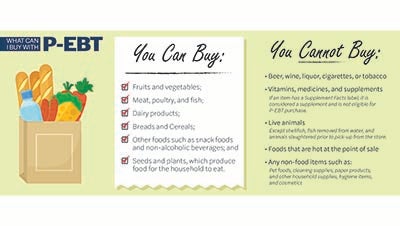JDC students will receive P-EBT funds for 2020-2021 school year
Published 8:18 am Wednesday, October 20, 2021
Parents of public school students in Mississippi who met certain requirements are beginning to receive food assistance payments from the Mississippi Department of Human Services and the Mississippi Department of Education.
MDHS and MDE have been authorized by the U.S. Department of Agriculture to provide Pandemic Electronic Benefit Transfer (P-EBT) payments to eligible families for the 2020-2021 school year and Summer 2021. These benefits are intended to help families with additional food costs their household may have experienced due to school closures during the past school year.
Around $246 million will be dispersed by late October, according to MDHS. About 345,000 students will qualify for the Summer 2021 benefit of $375 per child.
Only children who were eligible to receive free or reduced-price lunches under the National School Lunch Program are eligible to receive P-EBT benefits.
Benefits are calculated for each month of the school year based on the mode of learning used by the majority of students in that child’s school during that month. For instance, if an eligible student was under a hybrid schedule for one month, he or she would receive $61.38. If the student was under a virtual-only schedule for one month, he or she would receive $122.76 for the month. If the child was enrolled in a school with a majority in-person learning schedule for the month, no benefit will be paid for that month.
All monthly amounts the child is eligible to receive will be added together and issued as a single lump-sum payment for the 2020-2021 school year. Each child will receive his or her own card with their name on it specifically for P-EBT.
“We are very excited about this program and how it can benefit the students and families in our community,” said Jefferson Davis County Assistant Superintendent John Daley.
Students meeting the above requirements in the Jefferson Davis County School District will receive P-EBT cards with $613.80 for five months of virtual learning and $184.14 for three months of hybrid learning.
JDC parent Shonda Ard Burre thinks the P-EBT program is “right on time.”
“The pandemic caused us as parents to re-think our daily meals and snacks,” said Burre. During the entire pandemic, Burre had three school-aged children with her “pretty much daily.” “With children being at home all day during the school term, came extra food expense. The P-EBT provided my household with that extra support.”
Burre is also a Jefferson Davis County School Board member. Burre said having to make the decision to vote for our school district to remain virtual was “really difficult.”
“I often had sleepless nights worrying were the students in our district receiving the nutritional meals they deserved, so hearing our district was amongst the districts that would receive the extra support from P-EBT made it a little easier to decide safety first for our children.” Because the pandemic has been difficult to cope with, stressful and unpredictable, Burre feels “any extra support the community can receive is definitely a ray of sunshine in the midst of a cloudy, uncomfortable situation.”
Not every public school district has students that qualify for the P-EBT payments. For example, the Newton County School District in East Central Mississippi had in-person schedules for the majority of its students each month of the school year. No student in the district qualifies for P-EBT. At least 32 additional districts have no students that qualify.
To find out if your student’s district or school will receive payments and how much, access the full list at www.MDHS.gov/pandemic-ebt-p-ebt/p-ebt-schools-2/
If a child’s address has changed since June 2021, the child’s parent or guardian should contact both the P-EBT hotline at 833-316-2423 and their child’s school district to ensure their address is up-to-date.
If a parent or guardian is unsure if their student qualifies for a P-EBT payment, they should call the P-EBT hotline.
Funds will expire one year from the card’s activation date. Based on USDA regulations, cards can be used to purchase food for the household such as, fruits and vegetables; dairy products; meats, poultry and fish; breads and cereals; snack foods; non-alcoholic beverages; seeds and plants which produce food for the household. Funds cannot be used to purchase alcoholic beverages or tobacco products; vitamins, medicines or supplements; live animals; foods that are hot at point-of-sale; or any non-food items.





